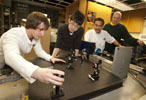
Japanese student continues research at Southeastern
Contact: Rene Abadie
2/11/11
Click on thumbnail for high resolution photo
Southeastern physics student Chad Sziszak, left, and visiting Japanese student Tatsuo Okiyama adjust the mirrors on the laser interferometry equipment used to evaluate weaknesses in materials. Observing are Professor of Physics Sanichiro Yoshida and Associate Professor William Parkinson.
HAMMOND – When Southeastern Louisiana University physics senior Chad Sziszak spent seven weeks in Japan last summer working on research projects with fellow students and faculty at Tokyo Denki University, he stayed with a student he befriended there.
Fast forward less than a year and that friend, graduate student Tatsuo Okiyama of Hachijo, Tokyo, is now staying with Sziszak at his Ponchatoula home while continuing their work of evaluating the strong and weak points of metal and other materials in the laser interferometry lab of Sanichiro Yoshida, Southeastern Alumni Association Endowed Professor of Physics.
A post-graduate in mechanical engineering, Okiyama is working with the Southeastern team. The lasers they use are aimed at various types of materials, including metals, plastics and even bone, explained Yoshida, who earned a patent for his laser interferometry technique that evaluates weaknesses in stretched materials.
“We’re now looking at bone using the same type of optical technique because of the role that stress plays on the human body and joints, often resulting in the need for artificial joints,” Yoshida explained.
Okiyama will return to Tokyo in a few weeks where he will continue the studies.
Sziszak’s experience last summer in Japan was “a blast,” he explained. The trip, made possible by a grant Yoshida received from the National Science Foundation to facilitate student experimental research in Japan, allowed Sziszak to enhance the research work started at Southeastern using the more sensitive and precise equipment at the Japanese university.
“To study material degeneration, we were using a high speed camera that can shoot one million frames per second,” said Sziszak, who plans to go into graduate studies in cosmology.
The trip also included time to take in some of the cultural aspects of the country, visiting the Japan Aerospace Exploration Agency, Railway Technical Research Institute, and Nissan Motor’s body assembly factory in Kyoto.
Okiyama’s trip to Louisiana likewise has included the opportunity to soak up some local culture: a tour of the Abita Brewery, a visit to the French Quarter in New Orleans and a Hornets game in the near future.
“He likes the food here too,” Sziszak says, “especially gumbo and boudin.”
Yoshida expects to send two or three additional Southeastern students to Japan this summer for research experience, with the possibility that additional Japanese students will return to Southeastern to work with his team.
“This is a tremendous learning opportunity for these students,” he said, “allowing them to interact with students from a different culture and perspective, the opportunity to work as undergraduates in well-equipped and sophisticated laboratories, and the personal attention they receive from the scientists they work with. It’s a great experience at many levels.”
More News...
